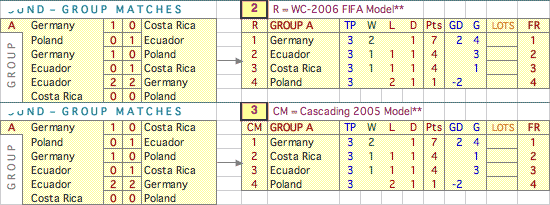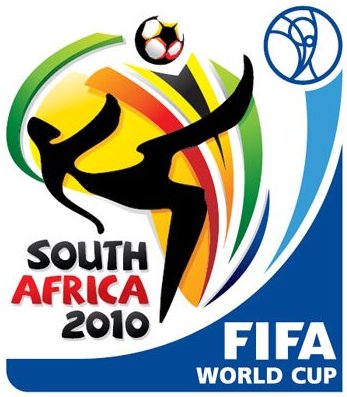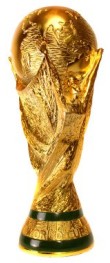Group Stage Scoring Models
For historical reasons and for the die-hard football fanatics who want to
experience alternate universes, there are three different scoring models
in our spreadsheet!
Our spreadsheet allows these three models:
2002 FIFA Straight Group Model
This was a simpler system that applied in 2002 with no tiebreaks after the Overall Group Table and a final drawing of lots. Enter "1" in the Model cell on the GroupResults page.
Winners were decided by:- Points in the overall group.
- Goal Difference in the overall group.
- Goals scored in the overall group.
- Drawing lots
2006+ FIFA Model
A Straight Group Model with one Mini-Group tiebreaker - the default model to be used in the tournament - enter "2" or even "bananas" in the Model cell. Our spreadsheet handles all of the FIFA criteria listed below:- greatest number of points obtained in all group matches;
- goal difference in all group matches;
- greatest number of goals scored in all group matches. If two or more teams are equal on the basis of the above three criteria, their rankings will be determined as follows:
- greatest number of points obtained in the group matches between the teams concerned;
- goal difference resulting from the group matches between the teams concerned;
- greater number of goals scored in all group matches between the teams concerned;
- drawing of lots by the FIFA Organising Committee."
2005 FIFA Cascading Mini-Group Model
This is the model that was to replace the 2002 model. It was discarded just before the 2006 World Cup in Germany. Ties are first resolved by looking at a mini-group: who won the game between the two teams that are tied in points? There is an extra Mini-Group for teams still tied after the first Mini-Group. If the Mini-Groups fail to resolve a tie, Overall Group goal difference (GD) and goals scored (G) should. Otherwise lots are finally drawn. Enter "3" in the Model cell to see if this happens.
- Points obtained in matches between the teams in question.
- Goal difference in matches between the teams in question.
- Goals scored in matches between the teams in question.
- Goal difference in all group matches.
- Goals scored in all group matches.
- Drawing of lots.
"The ranking of each team in each group will be determined as follows:
 |
| In the example above, Model 2 calls for no head-to head tiebreak; Ecuador (G = 3) pips Costa Rica (G = 1). In contrast, Model 3 calls for a tiebreak as both teams have 4 Points. Costa Rica's 1-0 victory over Ecuador in the fourth group-match gives it the edge; Overall Group G never comes into play because the Mini-Group resolved the tie. |
So...what happened?
 The 2002 Overall Group Model is simple to work out but gives an edge to the strongest
team if they score big against the weakest. This model was used from 1974 to 2002.
The 2002 Overall Group Model is simple to work out but gives an edge to the strongest
team if they score big against the weakest. This model was used from 1974 to 2002.
 What we're calling the "2005 Model" was an attempt to fix this. It favoured head-to-head results over Overall
Group GD and G in order to motivate teams to win all matches - rather than settle for qualifying for the knockout stage.
In a 4-way tie for example, the mini-group is the same overall group so the latter's Goal Difference and Goal counts apply immediately.
But having then used the one mini-group to apply GD and G, any further ties including a possible 3-way tie go straight to drawing lots!
The interpretability of the Regulations particularly in a 4-way tie swayed me to include different models in the spreadsheet.
But then Chris Bird ran
a computer simulation that predicted an increased likelihood of drawing lots with this model.1
Considering the expense, effort and interest in the World Cup, it would be a pity if a qualifier earned its place by 'lots'
instead of some performance-related measure or event such as a penalty shootout.
What we're calling the "2005 Model" was an attempt to fix this. It favoured head-to-head results over Overall
Group GD and G in order to motivate teams to win all matches - rather than settle for qualifying for the knockout stage.
In a 4-way tie for example, the mini-group is the same overall group so the latter's Goal Difference and Goal counts apply immediately.
But having then used the one mini-group to apply GD and G, any further ties including a possible 3-way tie go straight to drawing lots!
The interpretability of the Regulations particularly in a 4-way tie swayed me to include different models in the spreadsheet.
But then Chris Bird ran
a computer simulation that predicted an increased likelihood of drawing lots with this model.1
Considering the expense, effort and interest in the World Cup, it would be a pity if a qualifier earned its place by 'lots'
instead of some performance-related measure or event such as a penalty shootout.
 A short time before the 2006 Wold Cup in Germany, FIFA instituted the current system. It is described in detail by Aaron Williams, but he showed that,
unfortunately, there is still some ambiguity in interpreting rule (f).
A short time before the 2006 Wold Cup in Germany, FIFA instituted the current system. It is described in detail by Aaron Williams, but he showed that,
unfortunately, there is still some ambiguity in interpreting rule (f).

